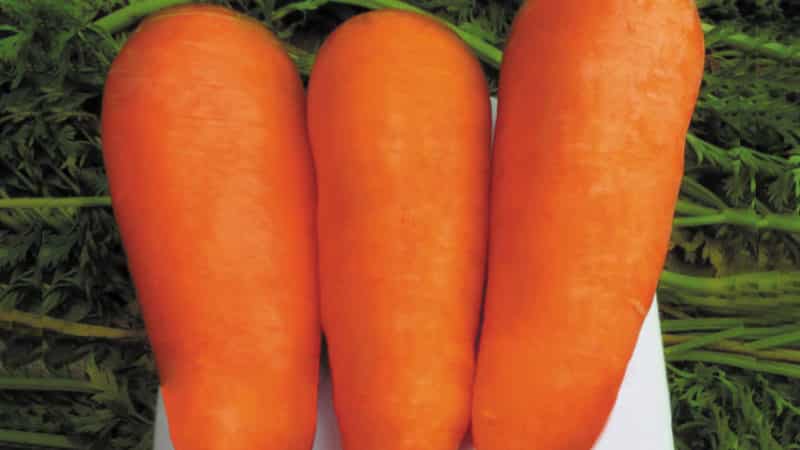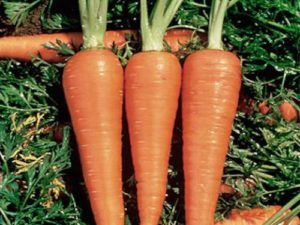High-yielding carrot hybrid Boltex with excellent taste
Carrots are the most consumed vegetable and are grown in every garden. Today we will talk about an exclusive new product of the Shantanay subvariety - the Boltex F1 hybrid. You will become familiar with the morphological characteristics, chemical composition and advantages of the variety, and in the article you will find practical advice on planting and growing crops and methods of storing the crop.
Description of the carrot hybrid Boltex
The mid-late hybrid Boltex F1 is produced by the French agricultural holding Tezier Clause. It produces a high yield of strong and juicy medium-sized root crops. Has a competitive advantage among late carrot varieties.

Origin and development
Boltex F1 is a daughter patented hybrid variety of the first generation of the Chantane variety. It belongs to heterotic varieties - superior in quality to its “parents”, obtained as a result of artificial pollination of flowers of different subspecies.
Chemical composition
The peculiarity of the Boltex hybrid is its low calorie content and high content of carotene, a healthy sugar. 100 g of homogeneous pulp contains only 43 kcal. Moreover, 90% of the root vegetable consists of water.
100 g contains 17.2% proteins, 2.3% fats and 80% carbohydrates, as well as:
- 2400 mg fiber (indigestible fiber) - stimulates gastrointestinal motility;
- 8.26 mg of beta-carotene - improves the condition of the visual organs;

- 0.15 mg of retinol - beneficial for the skin and mucous membranes;
- 0.03 mg of biotin - restores skin cells, participates in metabolic processes;
- 0.15 mg of pyridoxine - improves the process of hematopoiesis and blood composition, supports the functioning of the nervous system;
- 0.06 mg of thiamine - stimulates brain function, affects carbohydrate metabolism;
- 0.06 mg of riboflavin - improves hormone synthesis, normalizes the number of red blood cells in the blood;
- 0.01 mg phylloquinone - supports liver function;
- 5.7 mg of ascorbic acid - has a pronounced antioxidant effect, protects against viruses and infections;
- 0.7 mg of tocopherol - inhibits cell aging, improves blood flow.
Boltex carrots contain phytonutrients. Bioactive substances increase immune function and reduce the risk of cancer.
The variety has a rich mineral composition:
- potassium - 325 mg;
- magnesium - 13 mg;
- phosphorus - 35 mg;
- manganese - 0.15 mg;
- iron - 0.4 mg;
- copper - 0.05 mg.
Ripening time and yield
Mid-season Boltex carrots ripen in 110-125 days after the first shoots.
Subject to agrotechnical conditions, watering regime and timely fertilizing, the hybrid produces a high yield. Up to 8 kg of root crops are harvested from 1 m². Moreover, the weight of 1 fruit reaches 150-160 g.
On large farms, the average yield reaches 60-70 tons per hectare.
Disease resistance
Average resistance to flowering, bolting and cracking of root crops is observed.
High immunity to common crop diseases:
- downy mildew;
- cercospora;
- root rot;
- Alternaria blight.
Description of appearance
Boltex F1 belongs to biennial herbaceous plants of the Apiaceae family, a subspecies of wild carrots. A hybrid variety of the Shantane variety.
The rosette tops are spreading, powerful, and erect. The leaves are medium-sized, dissected, bright green in color.
The root crop is elongated, cone-shaped, with a blunt rounded tip. It grows up to 15 cm in length. The circumference at the base is up to 4-5 cm. The fruit is dark orange in color with juicy, uniform, dense pulp. The core is medium in size, not pronounced. The peel is thin, even and smooth. Due to the high content of sugar, beta-carotene, and dry substances, the taste is delicate, sweetish, without bitterness.
Presentation and taste are preserved for 10-12 months.
What regions is it suitable for?
The crop is cold-resistant and, with sufficient watering, tolerates summer heat well. The hybrid is adapted to heavy types of substrate.
Root crops have time to fully ripen in climate zones with short summers and frosty winters.
Hybrid Boltex is sown in Siberia and the Urals. It is also zoned in the northern, southern, and temperate latitudes of the country.
Advantages and disadvantages
Advantages of culture:
- equally high productivity in open ground and greenhouses;
- copes well with daily temperature fluctuations;
- seedlings germinate even during spring frosts down to –4°C;
- In cool summer conditions, root crops fully develop.
Among the disadvantages, farmers note:
- seed material is not cheap;
- hybrids do not produce high-quality seed “offspring”;
- in the second generation, morphological characteristics are lost, positive properties are scattered into the forms of predecessor parents.
Difference from other varieties and hybrids
Boltex F1, according to the Seed Supermarket magazine (No. 5, spring 2016), is recognized as the best variety for storage.
The pulp is homogeneous, the core also has an orange tint.
The improved subspecies is intended for winter planting; the root crops have time to ripen before the onset of cold weather.
Features of planting and growing
Upon landing For the Boltex F1 hybrid, it is important to take into account agronomic conditions, features of soil preparation, seed material and method of cultivation.
Preparing for landing
In April - early May the site is prepared:
- the beds are dug up;
- large clods are broken, the substrate is leveled with a rake;
- weeds are removed by the roots;
- During autumn digging, the beds are fertilized with compost, manure, and minerals.
It is important to treat the seeds with special growth preparations before planting. Stress adaptogens provide rapid adaptation and 100% germination. The seed material is soaked for 2-3 hours in the growth stimulator “Kornevin”, “Epin”, “Energen Aqua”.
Soil requirements
The variety is suitable for all types of soil, including heavy black soil, sandy loam and loamy soils. An important condition is a fertile layer of at least 20-25 cm.
Important! To reduce soil acidity, the Boltex liming method for carrots is not recommended. Use soft soil deoxidizers - dolomite flour or wood ash.
To improve moisture permeability and looseness, coarse river sand is added to heavy rocky soil or loams.
Predecessors
Boltex carrots grow well after garden crops:
- tomatoes;
- cabbage;
- Luke;
- garlic;
- hot and sweet pepper;
- early potato varieties;
- cucumbers
The culture grows and develops poorly after:
- greens (cilantro, parsley, dill);
- celery;
- beets;
- cumin.
Dates, scheme and rules of planting
Sow pre-treated seeds into open ground or a greenhouse in the first ten days of March (early spring sowing). Summer planting (to store the crop for the winter) is carried out at the very end of May or beginning of June.
Important! Late spring (pre-winter) crops provide full harvest, root vegetables are stored all winter, do not dry out, do not wrinkle, and retain their nutritional composition and taste.
Planting is carried out according to the following scheme:
- consumption rates are calculated in the ratio of 0.2 g per 1 m², respectively, 2 g (one packet of seeds) is enough for an area of 10 m²;
- row spacing - at least 15-20 cm;
- distance between seedlings - 3-4 cm;
- seeds are buried 1-2 cm;
- To ensure uniform distribution of seeds, sowing is carried out manually;
- the optimal temperature for sowing is 10-12°C;
- in cold regions, seeds germinate at a temperature of +5...+6°C;
- full-fledged root crops are formed and ripen at a temperature of +20...+23°C.
Features of cultivation
In dry, infertile soil, seeds do not germinate well, seedlings are weak, and often get sick and die.
It is important to comply with the depth standards. When planted deeply, the sprouts do not receive adequate nutrition. When planted superficially (without sufficient depth), germination is reduced due to the drying out of the top layer of the substrate. The sprouts grow variegated, with a delay of 7-10 days.
The culture prefers illuminated planting sites and tolerates summer heat well. Pre-winter sowing is carried out at the end of October or beginning of November, mainly in closed ground, with temperature regulation and lighting.
To maintain moisture exchange and soil moisture in the summer heat, the beds are mulched with sawdust or hay. In cold regions, immediately after sowing, it is recommended to cover the area with film overnight. During the day, the shelter is periodically removed for 1-2 hours for ventilation.
Watering mode
Abundant daily watering is recommended at the beginning of the growing season and during the formation of root crops. The optimal mode is regular, as the top layer dries. In moderate climates, watering once a week is sufficient.At the end of the formation of root crops, watering is reduced by 2 times, taking into account precipitation and temperature. Excess moisture causes cracking and warping. Substrate humidity 2 weeks before harvest should not exceed 60%.
Thinning and weed control
Weeding is carried out regularly, as it becomes clogged.. They loosen a week after seed germination (to a depth of no more than 7 cm), then at intervals of 14-15 days. When the seedlings have 1-2 true leaves, sow thin out, leaving a distance of up to 4 cm.
In order not to harm the roots, the soil is moistened before weeding and thinning the seedlings, and after weeding the rows are mulched.
Top dressing
Organic fertilizers are applied in advance when digging the site in the fall. Compost, a diluted solution of manure or litter, is suitable for these purposes.
Mineral complexes (potassium, phosphorus) are added throughout the entire period of growth and formation of root crops. The recommended dose of fertilizer is up to 15 g per 1 m².
For systemic feeding, fertilizers “Kemira” and “Nitrofoska” are used. In the northern regions - calcium sulfate at the beginning of the growing season.
Disease and pest control
Overwatering is unacceptable - root crops become infected with root rot, and the crop rots.
It is advisable to treat the seedlings and substrate with pesticides (“Fitoverm” is used to spray the tops). The last treatment is 3-4 days before harvest.
Important! Mulching beds protects against garden pests.
Organic matter (compost and manure), a layer of mulch (peat, sawdust) must be disinfected with urea.
Treatment with a solution of Bordeaux mixture or other fungicides and insecticides (antifungal drugs Intavir, Actellik) helps against powdery mildew, carrot fly, and spotting.
Harvest and storage
A harvest harvested on time is the key to good shelf life and long life. storage. It is not recommended to overcook root vegetables.
How and when to collect
The crop is harvested 3-3.5 months from the date of sowing.
Harvesting rules:
- stop feeding at least 3-4 days before;
- complete watering in a week;
- dig only in dry weather with a shovel;
- Use a sharp knife to cut off the tops.
Storage features and shelf life
The harvest is stored in special rooms (cellar, basement, barn). The optimal temperature is -2°C. Permissible air humidity is no more than 95%.
Important! When storing, avoid exposure to sunlight and moisture.
Storage method:
- in stacks;
- in bulk;
- in the pyramids;
- boxes;
- plastic bags;
- trenches and holes.
Immediately after harvesting, root crops are sorted and those damaged by diseases are removed. Dry for an hour. Cool in a darkened room for 7 days.
Damaged root vegetables are cleaned, grated, processed or sent to the freezer. This crop cannot be stored.
Difficulties in growing
The peculiarity of the variety is that the seedlings emerge slowly. Due to heavy spring rainfall and watering, the soil hardens, which complicates the germination and development of seedlings. It is important to prevent the formation of a soil crust. Timely weeding and surface loosening of the substrate is recommended.
They weed the beds regularly, at least 3-4 times per season. After watering, it is important to carry out hilling - bare root crops turn green from the sun.
Advice from experienced gardeners
If the area has not been fertilized since the fall, in the spring, after digging the beds, dolomite flour is scattered directly over the surface of the soil. Maintain proportions - 2 tbsp. per 1 m². Then the fertilizer is carefully covered with a rake to a length of teeth of 6-7 cm.It is at this depth that beneficial soil microorganisms and bacteria live.
It is important to water the furrows with warm water before burying the seeds. This procedure ensures rapid germination and activates growth processes.
Hybrid Boltex does not tolerate shading, especially at the beginning of the growing season. The seedlings stretch out, the root crops form crooked and small.
Agrotechnical trick. When grown on ridges and ridges, the amount of harvest increases by 1.5-2 times.
Reviews of the carrot hybrid Boltex
According to statistics from agricultural stores and supermarkets, Boltex carrots received 94% positive feedback. On the forums, summer residents give a positive assessment to the hybrid.
Vladimir D., Moscow region.: “I recommend Boltex to everyone. Great carrots are growing. The seeds, however, are expensive, but they are of high quality, and everything pays off. Sweet and juicy until spring, I store it downstairs in the refrigerator in plastic bags.”
Oksana M., Rostov: “Boltex - the price meets expectations, the carrots are just lovely! Children eat grated without sugar, it is so sweet. The manufacturer did not deceive, the original seeds give a good harvest.”
Conclusion
The carrot hybrid Boltex is an improved version of the Shantane variety, hardy and unpretentious. The manufacturer guarantees 100% germination on all types of soil, adaptation to climate and high yield. Taste and marketability are preserved for 7-10 months.